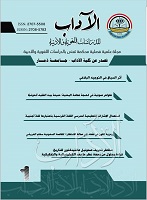Ibn Shihab Al-Alawi's Khodiawaiat: A study in their Artistic Construction
DOI:
https://doi.org/10.53286/arts.v1i1.225Abstract
Ibn Shihab Al-Alawi's Khodiawaiat (i.e. poems) are two ends plotted poems, said by the poet praising Al-Khodiywai Tawfiq. They occur in the forms and patterns of the two end poems that were spoken in praising the king, Mansour Ghazi Ibn Artiq, the owner of the Castle of Mardin in the eighth century AH. They were said by Safi Al-Din al-Hili (677 AH-749 AH) (1279 - 1348 AD). He was one of the poets of the Mamluk era (648 - 929 AH / 1250 - 1517 AD). Bano-Artaq, were a Turkmen Seljuk whose name were honorably associated with the State of Jerusalem and Palestine, during the Foreigners - Crusader wars that lasted two centuries (492 - 691 AH / 1096 - 1291 AD). This research briefly prefaces the way for the historical statement of this type of poetry within Safi AL-Din Al-Hili and his predecessors. Then, the research will deal with the Khodiawaiat (i.e. the poems) of the poet Abu-Bakr Bin Abdulrahman bin Shihab Al-Din (1262 AH - 1341 AH / 1922 AD). The research topic that texted within Safi AL-Din Al-Hili's plems' style in his collection called "Ibn Shehab", through a studying them in terms of their artistic construction; that includes, language, style, images, and music.Downloads
Download data is not yet available.
Downloads
Published
2021-05-27
How to Cite
Bayemen, A. A. A. . (2021). Ibn Shihab Al-Alawi’s Khodiawaiat: A study in their Artistic Construction. Arts for Linguistic & Literary Studies, 1(1), 78–111. https://doi.org/10.53286/arts.v1i1.225
Issue
Section
article
License
Copyright (c) 2021 أحمد علي أحمد بايمين

This work is licensed under a Creative Commons Attribution 4.0 International License.
Copyright and Licensing
copyright is retained by the authors. Articles are licensed under an open access Creative Commons CC BY 4.0 license, meaning that anyone may download and read the paper for free. In addition, the article may be reused and quoted provided that the original published version is cited. These conditions allow for maximum use and exposure of the work.



